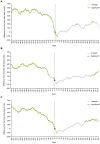Decreased step count prior to the first visit for MDD treatment: a retrospective, observational, longitudinal cohort study of continuously measured walking activity obtained from smartphones
- PMID: 37841742
- PMCID: PMC10569217
- DOI: 10.3389/fpubh.2023.1190464
Decreased step count prior to the first visit for MDD treatment: a retrospective, observational, longitudinal cohort study of continuously measured walking activity obtained from smartphones
Erratum in
-
Corrigendum: Decreased step count prior to the first visit for MDD treatment: a retrospective, observational, longitudinal cohort study of continuously measured walking activity obtained from smartphones.Front Public Health. 2024 Mar 12;12:1385467. doi: 10.3389/fpubh.2024.1385467. eCollection 2024. Front Public Health. 2024. PMID: 38532978 Free PMC article.
Abstract
Introduction: Major depressive disorder (MDD) is a common debilitating psychiatric condition and a major cause of productivity loss in workers. Using intermittent, subjective indicators, previous studies have shown that physical activity can predict lower levels of depressive symptoms. However, there is an unmet need for continuous and objective measures to identify MDD development before it results in productivity loss. The aim of this study was to elucidate the association between continuously measured walking activity and the development of MDD.
Methods: This retrospective, observational, longitudinal cohort study used health insurance claims data. Individuals aged 20-74 years were included if they had a record of MDD diagnosis and daily step count data for the 60 days before and after the first recorded MDD-related visit, which was defined as the index date. Multivariate analysis was conducted to compare 7-day moving averages of step counts on each day of the analysis period with the mean step count on the index date. Joinpoint regression analysis was used to determine when the trajectory of the moving step count average changed (inflection point).
Results: In total, 2,143 patients with a mean age of 41.2 (standard deviation [SD]: 10.6) years were included. The majority of patients were men (69.5%) and employed full-time (94.1%). Antidepressants were prescribed for 59.2% of patients. The 7-day moving average step count decreased from 6,310 (SD: 3758) at day -60 to 5,879 (SD: 3183) at the index date (first recorded MDD-related visit), and then increased to 6,062 (SD: 4029) at day +60. Compared with the index date, the 7-day moving average of step counts was significantly higher at days -60 to -1, +23 to +33, and + 42 to +60, and significantly lower at days +2 and + 3. Joinpoint regression analysis of 7-day moving average step counts from day -60 to day 0 identified an inflection point at day -14.
Conclusion: In working-age Japanese people, a formal diagnosis of MDD was preceded by a notable decline in daily step counts by approximately 2 weeks. MDD diagnosis and (presumed) treatment were followed by a gradual increase in daily step counts.
Keywords: Japanese; antidepressant; continuous monitoring; diagnosis; major depressive disorder; physical activity; step count.
Copyright © 2023 Fujino, Tokuda and Fujimoto.
Conflict of interest statement
FT and SF are employees of Takeda Pharmaceutical Company Limited. YF has a consulting service agreement with Takeda Pharmaceutical Company Limited and receives consulting fees. The authors declare that this study received funding from Takeda Pharmaceutical Company Limited. The funder had the following involvement: contribution to the study design and interpretation of the study results, involvement in the decision to submit, critical review of the manuscript, and approval of the final version for submission. All authors declare no other competing interests.
Figures





References
-
- Ministry of Health, Labor and Welfare of Japan . (2020). Occupational Safety and Health Survey. Available at: https://www.mhlw.go.jp/toukei/list/r04-46-50.html (Accessed November 14, 2022).
-
- Sumiyoshi T, Watanabe K, Noto S, Sakamoto S, Moriguchi Y, Tan KHX, et al. . Relationship of cognitive impairment with depressive symptoms and psychosocial function in patients with major depressive disorder: cross-sectional analysis of baseline data from perform-J. J Affect Disord. (2019) 258:172–8. doi: 10.1016/j.jad.2019.07.064 - DOI - PubMed
Publication types
MeSH terms
LinkOut - more resources
Full Text Sources

